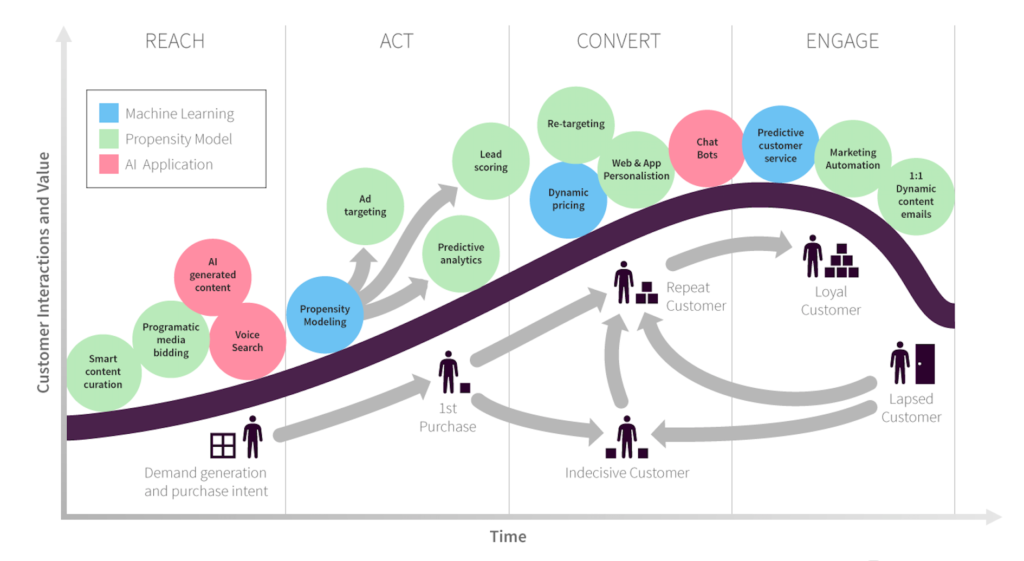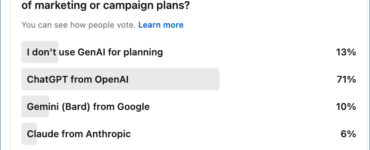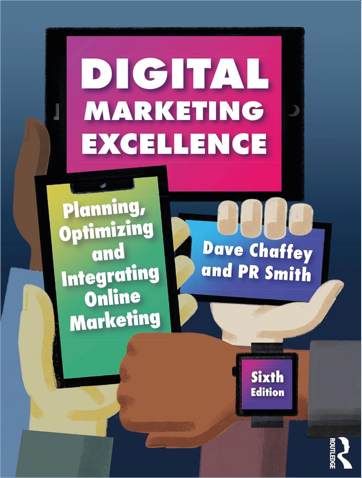15 marketing applications of Artificial Intelligence across the RACE marketing model
Artificial Intelligence is a term for a wide range of software and services which perform tasks previously requiring human analysis and interaction.
The aim of marketing applications of AI typically aim to improve the relevance and response of business-to-customer or business-to-business communications by techniques including targeting media, personalised messaging and customer service interactions.
Our Smart Insights post and infographic define 15 marketing applications of Artificial Intelligence across the RACE marketing model.
 The 15 options for applying marketing automation, with examples, include:
The 15 options for applying marketing automation, with examples, include:
1. AI generated content
For some types of content, AI content ‘Natural Language Generating (NLG) writing programs are able to pick elements from a dataset and structure a ‘human sounding’ article. An AI writing program called ‘WordSmith’from Automated Insights has been applied in several sectors:
- Associated Press produces nearly 4,000 company earnings articles quarterly – a 12-fold increase over its manual efforts.
- Processor vendor NVIDIA uses NLG and Tableau’s visual analytics to optimize internal reporting.
- Vivint Smart Home generates thousands of localized webpages, boosting SEO efforts and generating a 5X increase in sales.
- GreatCall delivers over 50,000 personalized narratives a week using natural language generation.
- com generates over 100,000 workout recaps every week to help users reach their fitness goals.
Another marketing-based AI application that can be used by email marketers is Phrasee. This uses AI technology to generate and optimise effective subject lines for emails. By using vast amounts of data on the effectiveness of email subject lines, it is able to get better results in terms of opens and clicks than human copywriters.
2. Smart Content Curation
AI-powered content curation allows you to better engage visitors on your site by showing them content relevant to them. This technique is most commonly found in the ‘customers who bought X also bought Y’ section on many sites, but can also be applied to blog content and personalizing site messaging and services more widely. Think of Netflix’s recommendation system being able to consistently recommend you shows you’d be interested it.
3. Voice search and Conversational User Interfaces
Voice search appliances or personal assistants have been developed by major online platforms like Facebook, Google, Amazon, Apple after the initial launch by Amazon with its Alexa home appliance. The implication for marketers is that as search queries become more conversational, they need to ensure they are answering the questions posed by searches in natural language
4. Programmatic Media Buying
Programmatic Media buying can use propensity models generated by machine learning algorithms to more effectively target ads at the most relevant customers.
5. Propensity modeling
Propensity modeling is the goal of a machine learning project. The machine learning algorithm is supplied with large amounts of historical data, and it uses this data to create a propensity model which (in theory) is able to make accurate predictions about the real world. =
6. Predictive analytics
Propensity modeling can be applied to a number of different areas, such as predicting the likelihood of a given customer to convert, predicting what price a customer is likely to convert at, or what customers are most likely to make repeat purchases. This application is called predictive analytics, because it uses analytics data to make predictions about how customers behave. The key thing to remember is that a propensity model is only as good as the data provided to create it, so if there are errors in the data or a high level of randomness, it will be unable to make accurate predictions.
7. Lead scoring
Propensity models generated by machine learning can be trained to score leads based on certain criteria so that your sales team can establish how ‘hot’ a given lead is, and if they are worth devoting time to. This can be particularly important in B2B businesses with consultative sales processes, where each sale takes a considerable amount of time on the part of the sales team. By contacting the most relevant leads, the sales team can save time and concentrate their energy where it is most effective. The insights into propensity to buy can also be used to target sales and discounts where they are most effective.
8. Ad targeting
Machine learning algorithms can run through vast amounts of historical data to establish which ads perform best on which people and at what stage in the buying process. Using this data they can serve them with the most effective content at the right time. By using machine learning to constantly optimize thousands of variables you can achieve more effective ad placement and content than traditional methods.
9. Dynamic pricing
All marketers know that sales are effective at shifting more product. Discounts are extremely powerful, but they can also hurt your bottom line. If you make twice as many sales with a two-thirds smaller margin, you’ve made less profit than you would have if you didn’t have a sale.
10. Web and App Personalisation
Using a propensity model to predict a customer’s stage in the buyer’s journey can let you serve that customer, either on an app or on a web page, with the most relevant content. If someone is still new to a site, content that informs them and keeps them interested will be most effective, whilst if they have visited many times and are clearly interested in the product then more in-depth content about a product’s benefits will perform better. .
11. Chatbots
Chatbots mimic human intelligence by being able to interpret consumer’s queries and complete orders for them. You might think chatbots are extremely difficult to develop and only huge brands with massive budgets will be able to develop them. But actually, using open chatbot development platforms, it’s relatively easy to create your own chatbot without a big team of developers.
Facebook is facilitating the development of chatbots for brands via its Messenger application which is another form of conversational UI. For example, Pizza Express have launched a new chatbot on Facebook Messenger, that allows users to book restaurants using Messenger.
12. Re-targeting
Much like with ad targeting, machine learning can be used to establish what content is most likely to bring customers back to the site based on historical data. By building an accurate prediction model of what content works best to win back different types of customers, machine learning can be used to optimize your retargeting ads to make them as effective as possible.
13.Predictive customer service
Inbound enquiries of all types can be routed to the relevant support article or customer support person via a series of questions. This rules-based customer service has been used for voice calls. AI enables more natural language questions to be asked which again route to the most relevant article or person. Bentoweb, Nanorep and Liveworld are examples of services for this application.
Predictive analytics can be used to work out which customers are most likely to unsubscribe from a service, by assessing what features are most common in customers who do unsubscribe. It’s then possible to reach out to these customers with offers, prompts or assistance to prevent them from churning.
14. Marketing automation
Marketing automation techniques generally involve a series of rules, which trigger interactions with the customer via messaging via Email, Smartphone notifications or web personalisation. Marketing automation adoption has been limited by the time needed to set up and optimize these rules. Machine learning can analyse customer interaction data and establish when are the most effective times to make contact, what words in subject lines are most effective and much more.






